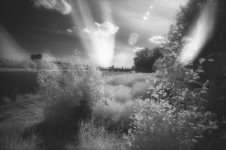kossi008
Photon Counter
Hi Folks,
I have tried the search function and found variuos statements that the CV 21/4 is not very prone to flare. Well, this might be true w/o filters, but I found some nasty flare spots when shooting b/w w/ yellow or orange filters already.
But last weekend I discovered the mother of all flares (excuse the stupid wordplay) when using Efke IR 820 film with a Heliopan RG715 filter. It looks like this, and the sun was not even inside the frame (see attached picture).
I am using the original short hood, which is bascially ineffective when screwing on any 39 mm filter. Should I get the bigger optional hood? Something else altogether? Any hints are appreciated...
Thanks,
Georg
I have tried the search function and found variuos statements that the CV 21/4 is not very prone to flare. Well, this might be true w/o filters, but I found some nasty flare spots when shooting b/w w/ yellow or orange filters already.
But last weekend I discovered the mother of all flares (excuse the stupid wordplay) when using Efke IR 820 film with a Heliopan RG715 filter. It looks like this, and the sun was not even inside the frame (see attached picture).
I am using the original short hood, which is bascially ineffective when screwing on any 39 mm filter. Should I get the bigger optional hood? Something else altogether? Any hints are appreciated...
Thanks,
Georg



